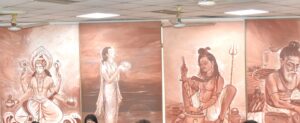What is a yoga introduction?
Yoga is an ancient system of philosophy and lifestyle. It is an art and science of healthy living. It is a spiritual discipline that brings harmony between mind and body. It acts as both a preventive and therapeutic method for dealing with health problems being faced by people and also for their rehabilitation in many situations.
Yoga is one of the oldest sciences that deal with the quality of human survival and existence in the world. Yoga is believed to have started at the very dawn of civilisation. UNESCO has recognised Yoga as an intangible cultural heritage of humanity. The United Nations General Assembly (UNGA) also recognised Yoga as one that provides a holistic approach to health and well-being. Yoga also brings synergy in all walks of life and, thus, is known for health promotion, disease prevention, and management of many lifestyle disorders.

Yoga involves a person’s physical, mental, and social aspects while providing wisdom, ethics, higher quality relationships, and the actual realisation of existing spiritual reality in every individual. In modern times, people practice Yoga to maintain their physical & mental health and well-being. Accordingly, Yoga institutions are developing various training programs to prepare Yoga teachers and therapists to serve and help ordinary people.
‘Yoga’ has been derived from the Sanskrit root ‘yuj’, which shows ‘to join’, ‘to yoke’, or ‘to unite’. According to Yogic traditional texts, the regular practice of Yoga leads to the union of individual consciousness with universal consciousness. A Yogi attains the state of freedom, referred to as Mukti, Nirvana, Kaivalya or Moksha. The aim of Yoga is self-realisation to overcome all kinds of sufferings, leading to ‘the state of liberation’.
Traditional definitions of Yoga
Yoga has been defined differently in various texts. Patanjali in Patanjala Yoga Sutra has explained Yoga as a method by which the restless mind (Chitta) can be calmed down by controlling mental modifications (Vrittis). Chitta denotes the reason in totality as it is taken as the first and finest evolutes of the matter (the primordial Nature or the Prakriti). After much contemplation, the learned Rishis (sages) concluded that, in its original form, Chitta is dominated by Sattva-guna. Still, because of various inputs from different sources, it gets disturbed and becomes unstable. This unstable mind (Chitta) gives rise to sorrows in life. Ancient Rishis discovered that Yoga could be used as a tool by which an unstable mind (Chitta) can be made steady and stable.
The Bhagawad Gita defines Yoga as the state characterised by the ‘equanimity of mind’ (Samatvam)and ‘skillfulness in action’ (Karmasu Kaushalam). It also advocates selfless work without expectation of the fruits of one’s actions (Nishkama Karma). Samatvam(equanimity) is a state of mind in which a person remains unaffected in various situations, such as success and failure, sorrows and happiness, losses and gains, and receiving and giving. This stability of mind frees a person from imbalances and helps make them stable and relaxed. Karmasu Kaushalam (skillfulness or excellence in action), as explained in the Bhagawad Gita, means performing an action or duty with dexterity. People should do their best using the available proper means without any expectation or attachment to the results. Yoga can, therefore, be termed as excellence/skillfulness in action.
The ultimate aim or goal of Yoga remains the same, i.e., attaining a balanced and integrated state of being/consciousness (Samadhi Bhavana), leading to total freedom and emancipation (Moksha). Regular practice of working with the self (Spiritual Yoga), an individual gets the light of the self, which leads towards self-realisation and starts giving rise to a ‘feeling of liberation’ (Moksha). Besides that, Yoga also helps to achieve life’s short-term and ever-changing goals depending on the demand or need in one’s life. Betterment in health condition, clarity in thoughts, etc., are short-term goals that keep changing according to the phases of life. Therefore, different Yogic traditions prescribe different practical approaches to satisfy and fulfil the stakeholders’ short-term goals, needs, and requirements.
Types of Yoga
Traditionally, three types of Yoga are understood.
- ‘Material Yoga’ (Bhautika Yoga): Yoga with various objects, events, and phenomena in the external world with the help of five sense organs (Pancha Jnanendriyas) and suitable motor actions (Pancha Karmendriyas).
- ‘Spiritual Yoga’ (Adhyatmika Yoga): Yoga with the ‘self’ by working with self-awareness. It may be in a well-balanced and integrated state (Samahita Chitta) or a disturbed state (Vyutthita Chitta). Usually, this type of Yoga is studied, understood, and presented as ‘Yoga’.
- ‘Transcendental Yoga’ (Parmarthika Yoga): Occasionally, specific inputs give rise to a universal consciousness where we forget ourselves and the objective material world.
